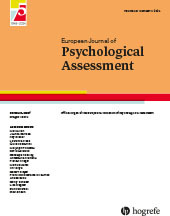The Impact of Different Methods to Correct for Response Styles on the External Validity of Self-Reports
Abstract
Abstract: Response styles (RSs) such as acquiescence represent systematic respondent behaviors in self-report questionnaires beyond the actual item content. They distort trait estimates and contribute to measurement bias in questionnaire-based research. Although various approaches were proposed to correct the influence of RSs, little is known about their relative performance. Because different correction methods formalize the latent traits differently, it is unclear how model choice affects the external validity of the corrected measures. Therefore, the present study on N = 1,000 Dutch respondents investigated the impact of correcting responses to measures of self-esteem and the need for cognition using structural equation models with structured residuals, multidimensional generalized partial credit models, and multinomial processing trees. The study considered three RSs: extreme, midpoint, and acquiescence RS. The results showed homogeneous correlation patterns among the modeled latent and external variables, especially if they were not themselves subject to RSs. In that case, the IRT-based models, including an uncorrected model, still yielded consistent results. Nevertheless, the strength of the effect sizes showed variation.
References
(2001). Response styles in marketing research: A cross-national investigation. Journal of Marketing Research, 38(2), 143–156. https://doi.org/10.1509/jmkr.38.2.143.18840
(2017). Response style analysis with threshold and multi-process IRT models: A review and tutorial. British Journal of Mathematical and Statistical Psychology, 70(1), 159–181. https://doi.org/10.1111/bmsp.12086
(1996). Dispositional differences in cognitive motivation: The life and times of individuals varying in need for cognition. Psychological Bulletin, 119(2), 197–253. https://doi.org/10.1037/0033-2909.119.2.197
(2012). mirt: A multidimensional item response theory package for the R environment. Journal of Statistical Software, 48(6), 1–29. https://doi.org/10.18637/jss.v048.i06
(2015). cocor: A comprehensive solution for the statistical comparison of correlations. PLoS One, 10(4), 1–12. https://doi.org/10.1371/journal.pone.0121945
(2016). A flexible full-information approach to the modeling of response styles. Psychological Methods, 21(3), 328–347. https://doi.org/10.1037/met0000059
(2008). Psychometric properties of the Dutch Rosenberg Self-Esteem Scale. Psychologica Belgica, 48(1), 25–35. https://doi.org/10.5334/pb-48-1-25
(1999). A broad-bandwidth, public domain, personality inventory measuring the lower-level facets of several five-factor models. Personality Psychology in Europe, 7(1), 7–28.
(1992). Measuring extreme response style. Public Opinion Quarterly, 56(3), 328–351. https://doi.org/10.1086/269326
(2014). Response styles and personality traits: A multilevel analysis. Journal of Cross-Cultural Psychology, 45(7), 1028–1045. https://doi.org/10.1177/0022022114534773
(2020). Different approaches to modeling response styles in divide-by-total item response theory models (part 1): A model integration. Psychological Methods, 25(5), 560–576. https://doi.org/10.1037/met0000249
(1999). Bayesian model averaging: A tutorial. Statistical Science, 14(4), 382–401. https://doi.org/10.1214/ss/1009212519
(2011). Response style behavior: question format dependent or personal style? Quality & Quantity, 47(1), 193–211. https://doi.org/10.1007/s11135-011-9511-4
(2020). The effect of rating scale length on the occurrence of inappropriate category use for the assessment of job satisfaction: An experimental online study. Journal of Well-Being Assessment, 4(1), 1–35. https://doi.org/10.1007/s41543-020-00024-2
(2015). Comparing extreme response styles between agree-disagree and item-specific scales. Public Opinion Quarterly, 79(4), 952–975. https://doi.org/10.1093/poq/nfv034
(2015). Maximum likelihood Bayesian model averaging and its predictive analysis for groundwater reactive transport models. Journal of Hydrology, 529, 1859–1873. https://doi.org/10.1016/j.jhydrol.2015.07.029
(2019). IRTree models with ordinal and multidimensional decision nodes for response styles and trait‐based rating responses. British Journal of Mathematical and Statistical Psychology, 72(3), 501–516. https://doi.org/10.1111/bmsp.12158
(1992). A generalized partial credit model: Application of an EM algorithm. Applied Psychological Measurement, 16(2), 159–176. https://doi.org/10.1177/014662169201600206
(2021). Developing and applying IR-tree models: Guidelines, caveats, and an extension to multiple groups. Organizational Research Methods, 24(3), 654–670. https://doi.org/10.1177/1094428120911096
(2018). A new model for acquiescence at the interface of psychometrics and cognitive psychology. Multivariate Behavioral Research, 53(5), 633–654. https://doi.org/10.1080/00273171.2018.1469966
(2020). True or false? Keying direction and acquiescence influence the validity of socio-emotional skills items in predicting high school achievement. International Journal of Testing, 20(2), 97–121. https://doi.org/10.1080/15305058.2019.1673398
(2019). Comparison of classical and modern methods for measuring and correcting for acquiescence. British Journal Mathematical and Statistical Psychology, 72(3), 447–465. https://doi.org/10.1111/bmsp.12168
(2000). The Rosenberg Self-Esteem Scale: Its dimensionality, stability and personality correlates in Estonian. Personality and Individual Differences, 28(4), 701–715. https://doi.org/10.1016/s0191-8869(99)00132-4
. (2021). R: A language and environment for statistical computing [Computer software]. R Foundation for Statistical Computing. https://www.R-project.org/
(2009). Multidimensional item response theory. Springer. https://doi.org/10.1007/978–0-387–89976-3
(2020). psych: Procedures for personality and psychological research [Computer software]. Northwestern University.
(2021). TAM: Test analysis modules [Computer software]. https://CRAN.R-project.org/package=TAM
(1965). Society and the adolescent self-image. Princeton University Press.
(2012). lavaan: An R package for structural equation modeling. Journal of Statistical Software, 48(2), 1–36. https://doi.org/10.18637/jss.v048.i02
(2022, June 14). Data and supplemental materials for “The impact of different methods to correct for response styles on the external validity of self-reports.” https://osf.io/jmkqg
(2010).
True longitudinal and probability-based internet panels: Evidence from the Netherlands . In M. DasP. EsterL. KaczmirekEds., Social and behavioral research and the internet: Advances in applied methods and research strategies (1st ed., pp. 77–104). https://doi.org/10.4324/9780203844922-4(2005). Simultaneous administration of the Rosenberg Self-Esteem Scale in 53 Nations: Exploring the universal and culture-specific features of global self-esteem. Journal of Personality and Social Psychology, 89(4), 623–642. https://doi.org/10.1037/0022-3514.89.4.623
(2010). Psychometric properties of the Rosenberg Self-Esteem Scale: Overall and across demographic groups living within the United States. Evaluation & The Health Professions, 33(1), 56–80. https://doi.org/10.1177/0163278709356187
(2019). Optimizing the length, width, and balance of a personality scale: How do internal characteristics affect external validity? Psychological Assessment, 31(4), 444–459. https://doi.org/10.1037/pas0000586
. (2021). RStan: The R interface to Stan [Computer software]. https://mc-stan.org
(2013). Response styles in survey research: A literature review of antecedents, consequences, and remedies. International Journal of Public Opinion Research, 25(2), 195–217. https://doi.org/10.1093/ijpor/eds021
(2010). The effect of rating scale format on response styles: The number of response categories and response category labels. International Journal of Research in Marketing, 27(3), 236–247. https://doi.org/10.1016/j.ijresmar.2010.02.004
(2016). A simulation study on methods of correcting for the effects of extreme response style. Educational and Psychological Measurement, 76(2), 304–324. https://doi.org/10.1177/0013164415591848
(2017). Multidimensional modeling of traits and response styles. European Journal of Psychological Assessment, 33, 352–364. https://doi.org/10.1027/1015-5759/a000291
(2020). Validity of three IRT models for measuring and controlling extreme and midpoint response styles. Frontiers in Psychology, 11, Article
271 . https://doi.org/10.3389/fpsyg.2020.00271(2007). Toward using confidence intervals to compare correlations. Psychological Methods, 12(4), 399–413. https://doi.org/10.1037/1082-989x.12.4.399



